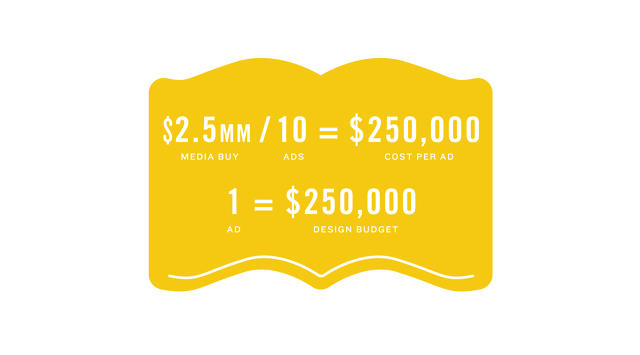Love our updates
Stay in the loop with logic


Someone, somewhere, at some time decided that the value of design directly correlates to the time spent solving a client’s problem. Today, most design firms use an hourly rate to determine creative services. Although clients may agree to a retainer, fixed fee, or equity swap, nearly all of the 30 firms I surveyed for this story first estimate their fees based on some hourly formula.
But anyone who works in a creative field knows that creativity isn’t something that starts when you punch a clock. How many times have you had a great idea in the shower? While stuck in traffic? While watching a football game? When a brilliant idea "strikes like lightning" is it less valuable? If a powerful concept evolves over months of intense effort, does that make it more valuable? Is the hourly model, then, really the best way to determine the value of design and branding services?
Sticker shock is always an obstacle when negotiating design fees. The design process is mysterious—even threatening—to some clients because they don’t understand it. It’s easy to fall into a "time trap" where clients equate time with value, which invariably ends with the question "Why will this take so long?"
THE MAGIC IN THIS PRICING MODEL IS THAT IT’S BUILT FROM THE CLIENT’S POINT OF VIEW.
In my experience, that gap in understanding can readily be solved by estimating the value for a design program in the client’s own terms, based on values that reflect the client’s particular business or industry. This "value mirror" approach offers a client-centric model that works at any scale. The magic in this pricing model is that it’s built from the client’s point of view, based on his or her own definition of value.
Here are some fictional examples of how this idea might work:

The international law firm KP&L realized it was time to refresh its 100-year-old brand. With 500 partners in 12 cities globally, it’s a legal powerhouse with annual revenues exceeding $1 billion. Gavel Design, a creative boutique with an impressive track record in the law profession, estimated its fee for a brand refresh to be close to a half a million dollars. A top lawyer in the firm was mystified: "How is it possible that a simple logo, some brochures and a website can cost so much?"
Gavel, using the value mirror approach, responded by showing how it used the average billing rate of each partner ($1,000 per hour) multiplied by the number of partners world-wide who would benefit from the new branding program, to arrive at its fee. In essence, the cost would be equal to the value of one hour of each partner’s time.

After purchasing eight well-established luxury hotels in Europe, Asia, and the Caribbean, a Saudi real estate developer needed to name his new venture and create an integrated branding program to attract his well-heeled target audience. With an average room rate of $1,500 per night, these exclusive hotels needed sophisticated marketing materials. Agency Blue was chosen to develop the branding program.
THE CLIENT DOESN'T NEED TO SEE YOUR INTERNAL MATH.
Forgoing the hourly rate model, the agency proposed a fee that was equivalent to the total revenue for 2,000 rooms across all properties multiplied by the average room rate per night for a single night.
Agency Blue’s proposed budget of $3 million dollars for a new name, brand identity, guest amenities, advertising, booking engine and online marketing would be a fraction of the cost the developer was estimating he would need to renovate the properties to his upscale standards.

As a rising star in the fashion world, Enrique Flores was ecstatic when a major apparel company from Shanghai made a multi-million dollar investment in his young company. His backers chose The Argyle Group to rebrand Flores’ company. In their contract negotiations, Argyle's and Flores’ team dispensed with the usual hourly calculation, choosing a creative model to estimate the cost for branding and design. Flores’s investors were accustomed to the cost of advertising in major fashion media. They had already budgeted $2.5 million for their annual media buy of 10 print ads in fashion publications. Using the logic of the value mirror for the Argyle Group’s work on a new logo and "look book" all parties agreed that the design and branding fee would be the equivalent of one full-page ad in, say, Vogue for roughly $250,000.
The value mirror approach suggests a new currency for designers and clients to use that demystifies the creative processes for design buyers. In these scenarios, the lawyer measures the design cost against his hourly consultation fee, the hotelier compares the expenses associated with a brand identity program with the cost of renovating a guest room, and the fashion investor understands the cost of rebranding because he already knows the rate for a full-page ad in a top-flight fashion magazine.
THE APPROACH INCREASINGLY BUDGET-CONSCIOUS CLIENTS AN ALTERNATIVE WAY TO UNDERSTAND DESIGN EXPENDITURES.
Our firm, CarboneSmolan, has been road-testing this approach for several years with great success. For example, I submitted a proposal for a sales campaign to sell condos in a luxury high-rise to one real estate developer. Our fee was equivalent to what he was paying the plumbing contractor. While this didn’t immediately seal the deal, it did set the bar for a meaningful negotiation about design and branding.
This approach also offers increasingly budget-conscious clients an alternative way to understand design expenditures. Since design programs such as the ones we’ve discussed are typically long-term investments, putting their cost in terms of similar expenses that a client might incur highlights their cost/benefit ratio in a way that a buyer better understands.
Old habits are hard to break and designers will continue to track their time to measure profitability. For example, we still begin our estimation of a project by calculating the number of hours it will likely take before looking for an equivalent cost that a particular client would better understand. (And, of course, we are always aware of the going market rate for various design services.) But that internal math needn’t be what the client sees. Aligning design services with how clients measure their own business success elevates the value of the creative process to the very tangible aspects of their industry that they already understand and respect.
Using the value mirror approach provides one handy way to arrive at a handshake on the enduring importance of great design and powerful branding. Give it a try.
Article from: http://www.fastcodesign.com/
Have something interesting you'd like to say on our blog?
Then please get in touch by clicking here